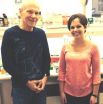(Press-News.org) Emotional eating is something we're all familiar with. Maybe you had had a rough week at work and all you want on Friday night is to plop down and watch a movie with a giant bowl of buttery popcorn. Maybe you're a student stressed about a big exam and you're munching on candy as you study. Or maybe your child's birthday party is coming up and you've bought an ice cream cake to serve a small army to celebrate. Happy or sad, up or down, there's a plethora of media in the world that tells us our moods often dictate the foods we choose to eat.
More recent studies, though, have shown that negative moods and positive moods may actually lead to preferences for different kinds of foods. For example, if given the choice between grapes or chocolate candies, someone in a good mood may be more inclined to choose the former while someone in a bad mood may be more likely to choose the latter.
But what if we could make better choices in any emotional state?
A forthcoming article by University of Delaware associate professor Meryl Gardner finds that there's more to stress eating than simply emotion and in fact, thinking about the future may help people make better food choices.
"We were interested in the 'why,'" said Gardner. "Why when someone is in a bad mood will they choose to eat junk food and why when someone is in a good mood will they make healthier food choices?"
Gardner, with co-authors Brian Wansink of Cornell University, Junyong Kim of Hanyang University ERICA and Se-Bum Park of Yonsei University, found that a lot depends on our perspective of time.
"In an evolutionary sense, it makes sense that when we feel uncomfortable or are in a bad mood, we know something is wrong and focus on what is close to us physically and what is close in time, in the here and now," said Gardner. "We're seeing the trees and not the forest, or how to do things and not why to do things."
To get at the "why," the researchers married the theories of affective regulation (how people react to their moods and emotions) and temporal construal (the perspective of time) to explain food choice.
They conducted four laboratory experiments to examine whether people in a positive mood would prefer healthy food to indulgent food for long-term health and well-being benefits and those in a negative mood would prefer indulgent foods to healthy foods for immediate, hedonistic mood management benefits.
In the first study, the researchers investigated the effect of a positive mood on evaluations of indulgent and health foods by examining 211 individuals from local parent-teacher associations (PTAs).
The findings indicated individuals in a positive mood, compared to control group participants in a relatively neutral mood, evaluated healthy foods more favorably than indulgent foods.
"We expect this is possibly because they put more weight on abstract, higher-level benefits like health and future well-being," said Gardner. "The remaining question was whether individuals in a negative mood would act differently."
Testing that question in a second study using 315 undergraduate students recruited from a large Midwestern university, the researchers found further support for their hypothesis that individuals in a negative mood liked indulgent foods more than healthy foods.
According to Gardner, the finding that people in a positive mood liked the more nutritious options and also liked the idea of staying healthy in their old age is consistent with the hypothesis that time construal is important.
"It suggests that positive mood makes people think about the future, and thinking about the future makes us think more abstractly," said Gardner.
The researchers were then left to eliminate goal achievement as an alternative explanation.
"Our manipulations of mood in the first two studies involved having participants read positive, negative or neutral articles," said Gardner. "As it turned out, the positive articles involved someone who had a great life and achieved lots of goals, and the negative articles involved someone who had a sad life and did not achieve goals. So the reviewers wondered whether the findings were due to the manipulation having involved goal achievement or the manipulation having led to different moods."
In order to prove the findings were not caused by differences in thinking about goal achievement, the researchers conducted a third study with an unrelated manipulation to show that mood not only affects evaluations of nutritious versus indulgent foods but also affects actual consumption.
Using raisins as health food and M&M's as indulgent food, Gardner said they altered participants' focus on the present versus the future along with their mood and measured how much of each food they consumed.
To get more insight into the underlying process, the fourth study focused specifically on the thoughts related to food choice, and differentiated concrete (taste/enjoyment-oriented) versus abstract (nutrition/health-oriented) benefits.
Ultimately, the findings of all the studies combined contribute to current research by demonstrating that individuals can select healthy or indulgent foods depending on their moods, an area previously under-represented in past clinical research on the role of healthy foods.
The findings also indicate the integral aspect of the time horizon, showing that individuals in positive moods who make healthier food choices are often thinking more about future health benefits than those in negative moods, who focus more on the immediate taste and sensory experience.
Finally – and this is where it gets even more interesting – Gardner and her partners found that individuals in negative moods will still make food choices influenced by temporal construal which supports the idea that trying to focus on something other than the present can reduce the consumption of indulgent foods.
"If people in a bad mood typically choose to eat foods that have an immediate, indulgent reward, it might be more effective to encourage what we call mood repair motivation, or calling their attention to more innocuous ways to enhance their mood," said Gardner. "Instead of looking at nutrition and warning labels, try talking to friends or listening to music."
So the next time you go to grab a snack, think about the future and you just might make a better food choice.
INFORMATION: END
Food & moods
Curb emotional eating by thinking about the future
2014-02-18
ELSE PRESS RELEASES FROM THIS DATE:
New treatment proposed to prevent intestinal inflammation in cancer patients
2014-02-18
Jerusalem, Feb. 18, 2014 – Experimental work pointing to a therapy for alleviating mucositis -- a common, severe side effect of chemotherapy and irradiation of cancer patients or patients prepared for bone marrow transplantation – has been achieved by an international team of researchers from the US and Israel headed by scientists at the Hebrew University of Jerusalem.
Mucositis is a strong inflammatory reaction of the mucosal lining of the digestive system, particularly the gut. Mucositis is often a major reason for premature suspension of anti-cancer therapy. As ...
Increase in Arctic cyclones is linked to climate change, new study shows
2014-02-18
Winter in the Arctic is not only cold and dark, it is also storm season when hurricane-like cyclones traverse the northern waters from Iceland to Alaska. These cyclones are characterized by strong localized drops in sea level pressure, and as Arctic-wide decreases in sea level pressure are one of the expected results of climate change, this could increase extreme Arctic cyclone activity, including powerful storms in the spring and fall.
A new study in Geophysical Research Letters uses historical climate model simulations to demonstrate that there has been an Arctic-wide ...
Saving Sochi's slopes: How artificial snow is made
2014-02-18
WASHINGTON, Feb. 18, 2014 — In what may be the warmest Winter Olympics on record, Sochi looks more like SoCal by the day. With few real snowflakes around to blanket Sochi's slopes, the latest episode of the American Chemical Society's Reactions YouTube series explains how science keeps the Winter Olympics alive with artificial snow. The video is available at http://youtu.be/ftMFMlk6FlA.
Producing artificial snow isn't as simple as grinding up big blocks of ice and spraying it on the slopes. Sochi's artificial snow guns — cannons that fire fake snow 20 to 30 feet in ...
Workers, get up and move
2014-02-18
Are you active at your job? If you're like most workers, you probably aren't. And the consequences could be deadly.
A team of researchers at the University of Iowa measured physical activity in police, whose jobs are presumably predicated on movement. Yet the group found that police officers burn as much energy on the job as someone sitting while holding a baby or washing dishes.
"We find that police work is primarily sedentary," explains Sandra Ramey, assistant professor in the UI College of Nursing. "The public view, how the media portray it on shows like 'Hawaii ...
When a black hole shreds a star, a bright flare tells the story
2014-02-18
Enrico Ramirez-Ruiz uses computer simulations to explore the universe's most violent events, so when the first detailed observations of a star being ripped apart by a black hole were reported in 2012 (Gezari et al., Nature), he was eager to compare the data with his simulations. He was also highly skeptical of one of the published conclusions: that the disrupted star was a rare helium star.
"I was sure it was a normal hydrogen star and we were just not understanding what's going on," said Ramirez-Ruiz, a professor of astronomy and astrophysics at the University of California, ...
Study points out inequalities in prescribing blood pressure meds
2014-02-18
Primary care doctors are not quick to prescribe antihypertensive medication to young people even after an average of 20 months of high blood pressure. Young adults who are white, male, not on Medicaid and not frequent clinic visitors are especially less likely to receive medication. These are the results of a study¹ by a research team at the University of Wisconsin School of Medicine and Public Health in the United States led by Heather Johnson. It appears in the Journal of General Internal Medicine², published by Springer.
One in every 10 Americans between the ages of ...
Blood test serves as 'crystal ball' for heart transplant patients, UCLA-led study finds
2014-02-18
A new UCLA-led study shows that a blood test commonly used to determine whether heart transplant recipients are rejecting their new organ can also predict potential rejection-related problems in the future.
Reporting in the online edition of the peer-reviewed journal Transplantation, researchers demonstrate how the AlloMap test, which uses a blood sample to measure changes in the expression of roughly a dozen genes, can be used over a period of time to assess the risk of dysfunction or rejection of a transplanted heart — months before such an event may occur.
"For ...
The thousand-droplets test
2014-02-18
This news release is available in German. An almost infinite number of complex and interlinked reactions take place in a biological cell. In order to be able to better investigate these networks, scientists led by Professor Friedrich Simmel, Chair of Systems Biophysics and Nano Biophysics at the Technische Universitaet Muenchen (TUM) try to replicate them with the necessary components in a kind of artificial cell. This is also motivated by the thought of one day using such single-cell systems for example as "nanofactories" for the production of complex organic substances ...
Nanodiamond-embedded contact lenses may improve glaucoma treatment
2014-02-18
By 2020, nearly 80 million people are expected to have glaucoma, a disorder of the eye that, if left untreated, can damage the optic nerve and eventually lead to blindness.
The disease often causes pressure in the eye due to a buildup of fluid and a breakdown of the tissue that is responsible for regulating fluid drainage. Doctors commonly treat glaucoma using eye drops that can help the eye drain or decrease fluid production.
Unfortunately, patients frequently have a hard time sticking to the dosing schedules prescribed by their doctors, and the medication — when ...
Ticks may cause double trouble, Stanford scientists find
2014-02-18
As winter turns to spring and many Northern Californians plan outdoor adventures, a mysterious, potentially debilitating threat looms.
A newly recognized human pathogen with unknown health consequences has been found to occur over a large part of the San Francisco Bay Area. A study to be published in the March issue of the journal Emerging Infectious Disease details how researchers including Dan Salkeld, a research associate at the Stanford Woods Institute for the Environment, found the bacterium, Borrelia miyamotoi, as well as Borrelia burgdorferi, the bacterium that ...
LAST 30 PRESS RELEASES:
Stardust study resets how life’s atoms spread through space
Practical education: Clinical scenario-based program development
The impact of family dynamics on eating behaviour – how going home for Christmas can change how you eat
Tracing the quick synthesis of an industrially important catalyst
New software sheds light on cancer’s hidden genetic networks
UT Health San Antonio awarded $3 million in CPRIT grants to bolster cancer research and prevention efforts in South Texas
Third symposium spotlights global challenge of new contaminants in China’s fight against pollution
From straw to soil harmony: International team reveals how biochar supercharges carbon-smart farming
Myeloma: How AI is redrawing the map of cancer care
Manhattan E. Charurat, Ph.D., MHS invested as the Homer and Martha Gudelsky Distinguished Professor in Medicine at the University of Maryland School of Medicine
Insilico Medicine’s Pharma.AI Q4 Winter Launch Recap: Revolutionizing drug discovery with cutting-edge AI innovations, accelerating the path to pharmaceutical superintelligence
Nanoplastics have diet-dependent impacts on digestive system health
Brain neuron death occurs throughout life and increases with age, a natural human protein drug may halt neuron death in Alzheimer’s disease
SPIE and CLP announce the recipients of the 2025 Advanced Photonics Young Innovator Award
Lessons from the Caldor Fire’s Christmas Valley ‘Miracle’
Ant societies rose by trading individual protection for collective power
Research reveals how ancient viral DNA shapes early embryonic development
A molecular gatekeeper that controls protein synthesis
New ‘cloaking device’ concept to shield sensitive tech from magnetic fields
Researchers show impact of mountain building and climate change on alpine biodiversity
Study models the transition from Neanderthals to modern humans in Europe
University of Phoenix College of Doctoral Studies releases white paper on AI-driven skilling to reduce burnout and restore worker autonomy
AIs fail at the game of visual “telephone”
The levers for a sustainable food system
Potential changes in US homelessness by ending federal support for housing first programs
Vulnerability of large language models to prompt injection when providing medical advice
Researchers develop new system for high-energy-density, long-life, multi-electron transfer bromine-based flow batteries
Ending federal support for housing first programs could increase U.S. homelessness by 5% in one year, new JAMA study finds
New research uncovers molecular ‘safety switch’ shielding cancers from immune attack
Bacteria resisting viral infection can still sink carbon to ocean floor
[Press-News.org] Food & moodsCurb emotional eating by thinking about the future



